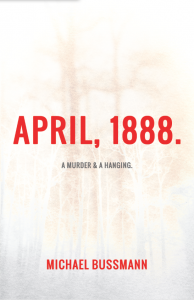 April 1988. A Murder & A Hanging.
April 1988. A Murder & A Hanging.
by Michael Bussmann
Patient Sounds, PSS004, February 2013
14 pages / $12 Buy from Patient Sounds
Only one chapbook among my small library of codices made the journey with me this summer from my home in North Carolina to New Haven, where I’ll live for perhaps only enough time to make it a home. The postmark on the miniature manila envelope housing the chapbook dates the mailing for February 11, 2013, and upon my arrival to my new dwelling place in August, I had yet to pinch the tiny metal wings to open the package. Six weeks of seminary soon handed me a divine urging for more verse, and because I had recently overdosed on Wiman in preparation for sharing the same building as the man, I opened the envelope waiting on top of My Bright Abyss. Shipping tape covered those metal wings, so I ripped it open with my teeth.
I wish I hadn’t waited so long to travel back to April, 1988. A Murder & A Hanging (Patient Sounds, 2012). Michael Bussmann, one of two poet laureates of Fort Collins, Co., during the year of the collection’s printing, curates his first chapbook under a theme of “hyper-local horror poetry.” Specifically, he tells the story of a real murder, or rather murders, in his small Colorado town using seven poems. Bussmann first heard the tale (likely over beers since he works for the brewery that now makes the town famous) from a buddy, and the swiftness of death from life has haunted him since.
Bussmann sets the stage in his introductory note:
James Howe murdered his wife, Eva, during the noon hour of April 3rd, 1988 in Fort Collins, Colorado…. He was an abusive alcoholic, and… [he] slit Eva’s throat in front of their house on Walnut Street, in broad daylight And in response, the town’s people chiseled James out of his jail cell and lynched him just hours after the murder. As it happened, James was the only lynching in the history of this fair town.
With “this fair town,” Bussmann shows, not tells, of his intimacy with Fort Collins, and it’s this relationship of place that contributes to the upsetting impact the horrid ballad has on him. “I have seen the sight [perhaps a purposeful homonym error] of the murder, and the hanging,” he notes. “And I have seen a piece of the rope they used to hang him.”
****
Bussmann begins his retelling with the site in “The Night Before” that ends with Eva’s ending the day of. He draws from his long nights in bars, on the job and other wise, in his deft description of James: “Long in night, he returns home too soon, / breath hot and rancid, stale from tall tales told.” Waking up in the morning after yelling, pints, and a forgotten teeth-brushing session bring me to James’s state. The taste is my mouth is a cross between peanut butter, sour patch kids, and old soy sauce.
It’s not long before Bussmann pairs these crude offensives with “beatings / and threats with knives” and Eva’s self-defense offense that starts as a thought and, like a buried lead, ends up a fatal action:
That night he slept, you didn’t. Pained
and packing the steamer trunk in your mind.
…
He sometimes lunched at home, but never
was the trunk packed. His eyes looked mean
and the knife came quickly. You pleaded, ran,
then cried murder (twice). Gertie wasn’t home
and for that you were grateful, and dead.
Bussmann’s spare but insightful use of a line break not solely before a transition shows he knows how to balladeer with suspenseful pauses (Compare, “He sometimes lunched at home, but never / was the trunk packed.” with “He sometimes lunched at home, / but never was the trunk packed.”) But I could have done without the concluding ode to Jerry Garcia. Instead of alarmed by a husband stabbing after his wife after she tries to leave an abusive relationship, I’m left thinking of “Sugar Magnolia” and Garcia’s missing middle finger.
Nonetheless, Bussmann soon recovers from a trite train of cocaine with the next two first-person poems from Eva and James, respectively. They further entrench the reader in the minds of two victims (everyone in this tale is a victim)—in a visceral, stream of consciousness manner. Quick, staccato pacing defines most of “Eva Howe, number one” as she looks down, unsure of what to do, where to go, and if she still lives:
Too much success
in this dress’s duty completion.
It soaked through
as the slit gaped,
everything went red, wet,
the breech kept my bleedables
bleeding.
Bussmann’s alliteration of “breech,” “bleedables,” and “bleeding” drives how much “red, wet” flows around Eva after James stabs her. With later mentions of “muddy ways,” “arterial,” “deluge,” “pool was warming,” and “wet and dead,” Bussmann wants the reader soaked in the drained liquid of life—now unlife.
He shifts viewpoints to the killer in “James Howe,” who appears more occupied with thoughts of his bed than on his poor dead mate:
The soft bed with its (now) ample room is
slightly acrid with this novel and bloody smell.
What has happened, just before now?
Beyond the footway’s darkness during lunchtime,
who’s to say … I found myself alone and dressed
in this bed, our (my) bed.
Bussmann’s parentheticals focus the reader’s attention on the newness of James’s situation. We discover the acute changes in James’s life at the same time he does. We don’t read after the fact; instead, we read with the fact.
READ MORE >

 Basal Ganglia
Basal Ganglia [SIC]
[SIC]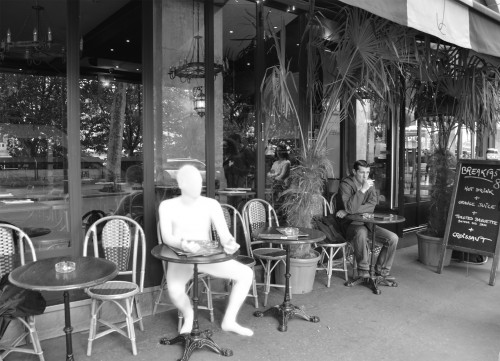
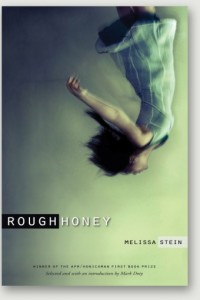 Rough Honey
Rough Honey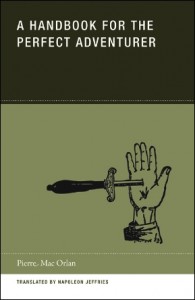 A Handbook for the Perfect Adventurer
A Handbook for the Perfect Adventurer
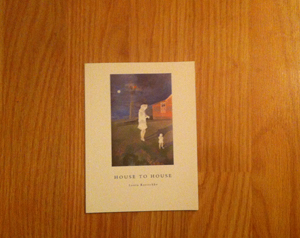 House to House
House to House
 April 1988. A Murder & A Hanging.
April 1988. A Murder & A Hanging.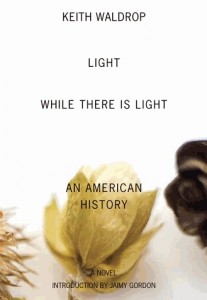 Light While There Is Light: An American History
Light While There Is Light: An American History I Am Ready To Die A Violent Death
I Am Ready To Die A Violent Death Rude Woods
Rude Woods